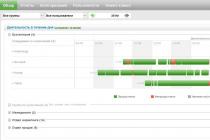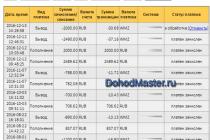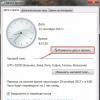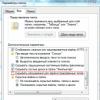Reverse current flow mechanism through the passage is relatively easy. The charge carriers, which are minor for one of the regions, drifting in the electric field of the space charge region, fall into the region where they are already the main carriers. Since the concentration of majority carriers usually significantly exceeds the concentration of minority carriers in the neighboring region (n n>> n p and p p >> p n), then the appearance in a particular region of the semiconductor of an insignificant additional amount of majority charge carriers practically does not change the equilibrium state of the semiconductor.
A different picture is obtained with the flow of direct current ... In this case, the prevailing diffusion component of the current, consisting of the majority charge carriers, overcome the potential barrier and penetrate into the semiconductor region, for which they are minority carriers. In this case, the concentration of minority carriers can increase significantly in comparison with the equilibrium concentration. The phenomenon of the introduction of nonequilibrium carriers is called injection.
When direct current flows through p-n- the transition from the electronic region to the hole one will be injection of electrons, from the hole region to the electron one - injection of holes.
For simplicity, in what follows, we will consider only the injection of holes from the hole region of the semiconductor into the electron region, then extending all the conclusions made to the counter process of electron injection into the hole region. If attached to p-n- transition voltage in the direction of transmission (Figure 3.13), then the height of the potential barrier will decrease, and a certain number of holes will be able to penetrate into n- region.
Figure 3.13. Diagram of the flow of direct current through the junction
Before these holes appear n- the region was electrically neutral, i.e. positive and negative charges in each of the sufficiently small volumes n- the areas in the sum were equal to zero.
Holes injected from R- areas in n- area, represent some positive space charge. This charge creates an electric field that propagates in the volume of the semiconductor and sets in motion the main charge carriers - electrons. The electric field created by the holes attracts electrons to the holes, the negative space charge of which should compensate for the positive space charge of the holes. However, the concentration of electrons near the space charge of the injected holes will lead to a decrease in their concentration in adjacent volumes, i.e. to the violation of electrical neutrality and the appearance of a space charge in these volumes.
Since no redistribution of free charges inside an electrically neutral semiconductor can compensate for the space charge of holes, an additional number of electrons must enter from the external terminal to restore the state of electrical neutrality of the semiconductor, the total charge of which will be equal to the total charge of the injected holes. Since an electron and a hole have charges of equal magnitude and opposite in sign, the number of electrons entering the volume of the semiconductor from the external terminal should be equal to the number of injected holes.
Thus, simultaneously with the appearance in n- the region of a certain number of injected holes - minor non-equilibrium carriers - the same number of electrons appears - main nonequilibrium carriers. Both those and other carriers are nonequilibrium, since they create a concentration that differs from the concentration of thermodynamic equilibrium.
The process of compensation of the space charge of minority nonequilibrium carriers by the space charge of major nonequilibrium carriers proceeds extremely quickly. The settling time of this process is determined by the relaxation time
and is for germanium (ε = 16), the resistivity of which is 10 Ohm. cm, about 10-11 sec. The establishment of a process can therefore be considered instantaneous.
Since the concentration of carriers is high directly at the junction, the carriers, due to the presence of a concentration gradient, will propagate deep into the bulk of the semiconductor in the direction of lower concentrations. At the same time, the concentration of nonequilibrium carriers will decrease due to recombination, so that the total concentration value will tend to the equilibrium value.

Figure 3.14. The distribution curve of the concentration of nonequilibrium non-basic
carriers (holes) in the electronic region of the pn junction
If the nonequilibrium concentration is small in comparison with the concentration of equilibrium majority carriers (low injection level), then the decrease in the concentration of nonequilibrium carriers in the direction from the transition into the interior of the semiconductor will occur exponentially (Fig. 3.14):
![]() (3.23)
(3.23)
L characterizes the average distance to which the carriers manage to diffuse during their lifetime.
At a point far enough from the transition (x →¥ ) the equilibrium concentration of charge carriers will be maintained.
At a low injection level, the concentration of nonequilibrium carriers in n- the region near the interface will exponentially depend on the magnitude of the voltage applied to the junction:
![]() (3.24)
(3.24)
(at U= 0; increases rapidly with increasing positive values U).
Note that the change in voltage across the junction by Δ u will lead to an increase in the concentration of nonequilibrium holes in n- area, i.e. to a change in charge. A change in charge caused by a change in voltage can be viewed as the action of some capacity. This capacity is called diffusion , since it appears due to a change in the diffusion component of the current through the junction.
It can be concluded that diffusion capacitance will manifest itself at forward currents through the junction or at low reverse voltages, when the value of the diffusion current cannot yet be neglected in comparison with the conduction current.
We represent the diffusion capacity as a change in charge Δ Q related to the voltage change Δ that caused it u:
and estimate the influence of the current through the junction on the value of the diffusion capacity.
The total charge of minority nonequilibrium carriers in n-area can be obtained by integrating expression (3.23).
When an alternating voltage is applied to the p-n-junction, capacitive properties are manifested.
The formation of a p-n junction is associated with the appearance of a space charge created by stationary ions of donor and acceptor atoms. An external voltage applied to the pn junction changes the amount of space charge in the junction. Consequently, the p-n junction behaves like a kind of flat capacitor, the plates of which are n- and p-type regions outside the junction, and the insulator is a space-charge region depleted in charge carriers and having a high resistance.
This p-n-junction capacitance is called barrier ... Barrier capacity C B can be calculated by the formula
S is the area of the p-n-junction; e · e 0 - relative (e) and absolute (e 0) dielectric constants; D is the width of the pn junction.
A feature of the barrier capacitance is its dependence on the external applied voltage. Taking into account (2.2), the barrier capacitance for an abrupt transition is calculated by the formula:
 ,
,
where the sign "+" corresponds to the reverse, and "- to the forward voltage at the junction.

The dependence of the barrier capacitance on the reverse voltage is called the capacitance-voltage characteristic (see Fig. 2.6). Depending on the junction area, dopant concentration and reverse voltage, the barrier capacitance can take values from units to hundreds of picofarads. Barrier capacitance manifests itself in reverse voltage; with forward voltage, it is shunted by a small resistance r pn.
In addition to the barrier capacity, the p-n-junction has a so-called diffusion capacity. Diffusion capacity is associated with the processes of accumulation and resorption of a nonequilibrium charge in the base and characterizes the inertia of the motion of nonequilibrium charges in the base region.
The diffusion capacity can be calculated as follows:
 ,
,
where t n is the lifetime of electrons in the base.
The diffusion capacity is proportional to the current through the pn junction. At forward voltage, the diffusion capacity can reach tens of thousands of picofarads. The total capacity of the p-n-junction is determined by the sum of the barrier and diffusion capacities. At reverse voltage C B> C DIF; at forward voltage, the diffusion capacity prevails C DIF >> C B.

The equivalent circuit of the p-n-junction on alternating current is shown in Fig. 2.7. In the equivalent circuit, parallel to the differential resistance of the p-n-junction r pn, two capacitors C B and C DIF are connected; the bulk resistance of the base r ¢ B is connected in series with r pn. With an increase in the frequency of the alternating voltage applied to the p-n-junction, the capacitive properties manifest themselves more and more, r pn is shunted by the capacitive resistance and the total resistance of the p-n-junction is determined by the bulk resistance of the base. Thus, at high frequencies, the pn junction loses its nonlinear properties.
Diode types
Diodes are classified:
1. By frequency:
2. low frequency;
3.Mid-frequency;
4. high frequency;
5. Microwave - diodes.
6. By manufacturing technology:
7.point;
8. floatable;
9. diffusion.
10. By functional purpose:
11. rectifier;
12. universal;
13.LEDs;
14. tunnel diodes.
The main characteristics of a rectifier diode are the following parameters: I pr, U pr, I pr max, U pr max, I arr, U arr max, r diff, where r diff- diode differential resistance:.
For a zener diode, the main parameters are I s min, I s max, U s min, U s max, in addition to the zener diode (determined at the operating point), nominal data and breakdown voltage U arr max... Also given is TKN (Temperature Coefficient of Voltage):  or in %
on the ° C:
or in %
on the ° C:  .
.
Pulse diodes are characterized by an operating frequency f and impulse response: t east(the time it takes the diode to restore its properties), the capacity of the p-n-junction C pn and the same characteristics as rectifier diodes: I pr, I arr etc.
Power supply system. Classification and characteristics of rectifiers. Single and full wave rectifier with R load.
Power supplies make up the bulk of an electronic device. About 50% from the weight of the equipment is a power supply due to the fact that it usually includes a transformer, which has large dimensions and weight.
The power supply unit consists of: transformer, diode circuit, smoothing filter and stabilizer .
Power supply system - a set of primary and secondary power supplies.
Primary power supplies - devices that convert non-electrical energy into electrical energy (generators, etc.)
Secondary power supplies - devices that convert one type of electrical energy into another (for example, alternating current into direct current ( rectifiers ), direct current to alternating current ( inverters )).
Transformer designed to match the diode circuit with the mains supply. The ratio of the number of turns of the secondary and primary windings is called the transformation ratio. The second purpose of the transformer is to isolate the diode circuit from the network if the load is grounded.
Diode circuit is designed to rectify the voltage at the input and obtain a certain constant component at the output.
U d- constant voltage component;
I d- constant current component.
Depending on the type of diode circuit, the quality of the voltage at the output of the diode circuit is different. This quality evaluates the ripple coefficient:
 .
.
The ripple factor can be either greater than 1 (for full-wave rectifiers) or less than 1 (for half-wave rectifiers).
Passive RC and LC filters are used as smoothing filters (more often LC filters are used). One link of the LC filter reduces the ripple coefficient by no more than 25 times. For a stronger reduction K p 2- or 3-link filters are used. (if the number of links is more than 3, self-excitation is possible).
Stabilizer designed to further reduce ripple (reduces K p 1000 or more times). As a rule, it is based on integrated microcircuits (op-amp or special microcircuits).
The combination of a transformer, a diode circuit and a smoothing filter is called rectifier ... The main characteristics of the rectifier are:
1) average rectified load current I 0;
2) average rectified load voltage U 0;
3) coefficient of ripple on load K n0;
4) external characteristic of the rectifier U 0 = U 0 (I 0).
Half-wave rectifier circuit.
 |
 |
We will show the processes occurring in the circuit on oscillograms:
V positive half-cycle voltage U 2 diode VD opens and current flows through the load i 2 equal i d... In this case, the voltage across the load has a sinusoidal character with an amplitude U 2 m(we neglect the voltage drop across the diode).
V negative half-cycle voltage U 2 diode VD is closed and reverse voltage is applied to it U arr max = U 2 m... Thus, the voltage and current across the load have a pulse character (from 0 to p- sinusoidal character and from p before 2p voltage and current are zero).
Let's define the characteristics of the rectifier:
1. Effective voltage of the secondary winding of the transformer:
denote wt = u, then  or
or ![]() .
.
From here, one can immediately see the disadvantage of a half-wave rectification circuit: the average rectified winding voltage is more than 2 times less U 2.
, where I 2 m- current amplitude of the secondary winding of the transformer.
Knowing the relationship between U d and U 2 you can write the following expression:
I 2 = 1.57I d,where I d- average rectified current.
These expressions make it possible to determine the power of the secondary winding of the transformer, as well as to obtain the requirements for the winding wire of the secondary winding ( P 2 = U 2 I 2).
3. The effective value of the current of the primary winding of the transformer:
the relationship between the current of the primary and secondary windings is linear, where n- transformation ratio. In turn i 2 = I 2 -I d, then ![]() ... Determine the effective value of the current i 1 (I 1):
... Determine the effective value of the current i 1 (I 1):
.
Next, you can determine the power P 1 primary winding of the transformer ( P 1 = U 1 I 1). Knowing the power of the primary and secondary windings, you can calculate the typical power of the transformer ( S): ![]()
4. Reverse voltage across the diode ![]()
5. The frequency of the first harmonic of the voltage across the load ( f n1): f n1 = f network = 50 Hz.
Hence follows the second disadvantage of a half-wave rectification circuit. It consists in the fact that at a frequency 50 Hz when constructing a smoothing filter, more cumbersome L and C are needed.
6. Ripple coefficient, where U 1 m is determined by the Fourier series expansion of the voltage curve across the load (for a half-wave rectification circuit U 1 m> U d, which is also its disadvantage).
Because in the current of the secondary winding there is a constant component equal to I d, then the transformer undergoes forced bias, therefore, the signal at the output of the transformer may be distorted due to its saturation. To avoid this, the size of the transformer is increased.
Due to the listed disadvantages, this circuit is used if high quality of the output signal is not required.
Full-wave midpoint circuit.
It contains a transformer with a middle terminal and two diodes. Consists of two half-wave rectifiers.

W '2 = W' '2; 
Its drawback is immediately visible from the diagram: the need to output the midpoint of the transformer and the same number of turns of the secondary winding.
 |
Let's draw the timing diagrams:
Let's consider the operation of this scheme.
In the positive half-cycle, the diode VD1 is open and the diode current flows through the load i d1... Amplitude of load voltage U n max = U 2 m... In the negative half-cycle, the diode VD1 closes and the diode VD2 opens, since the half-windings are identical, the amplitude of the voltage across the load will also be equal U 2 m... The voltage across the load has a pulse nature, and the frequency of the fundamental harmonic is 2 times higher than the mains frequency ( f n1 = 2f network). The current flowing in each of the half windings is nonzero for one half cycle. With respect to the transformer core, the magnetic fluxes created by the half-winding currents are sinusoidal. Therefore, we can assume that the secondary current of the transformer (relative to the core) has a sinusoidal character.
The main characteristics of the rectifier.
1. Average rectified load voltage U d:
since This rectifier is a combination of two half-wave rectifiers, then:.
2. The effective value of the current of the secondary winding of the transformer:
since the nature of the current flowing through the half-winding of the transformer (in comparison with a half-wave rectifier) has not changed, then the ratio will be the same:.
Further, having made similar conclusions as for a half-wave rectifier, we get:
The disadvantages of the circuit include the complication of the circuit and the design of the transformer.
Ideally, the reverse current, even at a relatively low reverse voltage, does not depend on the value of the latter. However, in real studies, a fairly strong increase in the reverse current is observed with an increase in the applied voltage, and in silicon structures, the reverse current is 2-3 orders of magnitude higher than the thermal one. This difference between experimental and theoretical data is explained by the hermetic generation of charge carriers directly in the region and by the existence of channel currents and leakage currents.
Channel currents are caused by the presence of surface energy states that distort energy bands near the surface and lead to the appearance of inverted layers. These layers are called channels, and the currents flowing through the junction between the inverse layer and the adjacent region are called channel currents.
Capacities of the p-n-junction.
Along with electrical conductivity, the -junction also has a certain capacitance. Capacitive properties are due to the presence of electric charges on both sides of the boundary, which are created by impurity ions, as well as mobile charge carriers located near the boundary.
Capacity is subdivided into two components: barrier, reflecting the redistribution of charges in, and diffusion, reflecting the redistribution of charges near. With the forward bias of the junction, the diffusion capacity is mainly manifested; with the reverse (extraction mode), the charges near (in the base) change little and the barrier capacity plays the main role.
Since the external voltage affects the width, the space charge value and the concentration of the injected charge carriers, the capacitance depends on the applied voltage and its polarity.
The barrier capacitance is due to the presence of donor and acceptor impurities in the -junction, which form, as it were, two charged capacitor plates. With a change in the blocking voltage, for example, an increase, the width of the -junction increases and some of the mobile charge carriers (electrons in the region and holes in the region) are sucked off by the electric field from the layers adjacent to the junction. The movement of these charge carriers causes a current in the circuit
![]()
where is the change in the charge of the depleted junction layer. This current becomes equal to zero at the end of the transient process of changing the boundaries of the -transition.
The value for an abrupt transition can be determined from the approximate expression
![]()
where are the area and thickness at.
With an increase in the applied reverse voltage U, the barrier capacitance decreases due to an increase in the thickness of the junction (Fig. 2.10, a).
The dependence is called the capacitance-voltage characteristic.
When a forward voltage is connected to a p-n-junction, the barrier capacitance increases due to a decrease. However, in this case, the increment of charges due to injection plays an important role, and the capacitance of the -junction is determined mainly by the diffusion component of the capacitance.
The diffusion capacitance reflects the physical process of changes in the concentration of mobile charge carriers accumulated in the regions due to a change in the concentration of injected carriers.
The effect of diffusion capacity can be illustrated by the following example.
Let a direct current flow through, due to the injection of holes into the base region. The base accumulates the charge created by minority carriers, proportional to this current, and the charge of the majority carriers, which ensures the electroneutrality of the semiconductor. With a rapid change in the polarity of the applied voltage, the injected holes do not have time to recombine and, under the action of the reverse voltage, go back to the emitter region. The main charge carriers move in the opposite direction and leave along the power bus. In this case, the reverse current is greatly increased. Gradually, the additional charge of holes in the base disappears (dissolves) due to their recombination with electrons and return to the -region. The reverse current decreases to a static value (Fig. 2.10. B).

Rice. 2.10. Capacitance-voltage characteristics (a) and the change in current when the voltage polarity changes (o): 1 - smooth transition; 2 - abrupt transition
The junction behaves like a capacitance, and the charge of the diffusion capacitance is proportional to the forward current that previously flowed through the junction.

A change in the external voltage dU at the p-n junction leads to a change in the accumulated charge dQ in it. Therefore, the p-n junction behaves like a capacitor, the capacitance of which is C = dQ / dU.
Depending on the physical nature of the changing charge, barrier (charging) and diffusion capacities are distinguished.
The barrier (charging) capacity is determined by the change in the uncompensated charge of the ions when the width of the barrier layer changes under the influence of an external reverse voltage. Therefore, an ideal electron-hole junction can be regarded as a flat capacitor, the capacitance of which is determined by the relation
where П, d are the area and thickness of the p-n junction, respectively.
From relations (1.41) and (1.31) it follows
 .
.
In the general case, the dependence of the charging capacity on the reverse voltage applied to the p-n junction is expressed by the formula
 ,
,
where C 0 is the capacity of the p-n junction at U OBR = 0; g - coefficient depending on the type of p-n transition (for sharp p-n transitions g = 1/2, and for smooth g = 1/3).
The barrier capacity increases with an increase in N A and N D, as well as with a decrease in the reverse voltage. The nature of the dependence C BAR = f (U OBR) is shown in Fig. 1.13, a.
Consider the diffusion capacity. As the external voltage applied to the p – n junction in the forward direction increases, the concentration of injected carriers near the junction boundaries increases, which leads to a change in the amount of charge caused by minority carriers in the p and n regions. This can be seen as a manifestation of some capacity. Since it depends on the change in the diffusion component of the current, it is called diffusion. The diffusion capacitance is the ratio of the increment of the injection charge dQ inzh to the voltage change dU pr that caused it, i.e. ![]() ... Using equation (1.30), one can determine the charge of injected carriers, for example, holes in the n-region:
... Using equation (1.30), one can determine the charge of injected carriers, for example, holes in the n-region:

Figure 1.13 Dependence of the barrier (a) and diffusion (b) capacities of the p-n junction on the voltage.
Then the diffusion capacity, caused by a change in the total charge of nonequilibrium holes in the n-region, is determined by the formula
 .
.
Similarly, for the diffusion capacitance due to the injection of electrons into the p-region,
 .
.

Figure 1.13 Equivalent p-n junction circuit.
Total diffusion capacity
The dependence of the capacitance on the forward voltage at the p-n junction is shown in Figure 1.13, b.
The total capacity of the p-n junction is determined by the sum of the charging and diffusion capacities:
![]() .
.
When the p-n junction is turned on in the forward direction, the diffusion capacity prevails, and when turned on in the opposite direction, the charging capacity prevails.
In fig. 1.14 shows the equivalent circuit of the p-n junction in alternating current. The circuit contains the differential resistance of the pn junction r D, the diffusion capacitance C of the DIF, the barrier capacitance C of the BAR and the resistance of the volume of the p- and n-regions r 1. Based on equation (1.37), you can write:
![]() .
.
If, with direct switching on of the p-n transition U pr >> j t, then:
At room temperature ![]() ; (1.42)
; (1.42)
(in relation (1.42) the current value is substituted in amperes). Leakage resistance r УТ takes into account the possibility of current passing over the crystal surface due to the imperfection of its structure. With direct connection of the p-n junction WITH BAR<< С ДИФ, дифференциальное сопротивление r Д ПР мало и соизмеримо с r 1 , поэтому эквивалентная схема принимает вид, показанный на рис. 1.15, а.

Figure 1.15 Simplified pn junction equivalent circuits.
With a reverse bias r D OBR >> r 1, S BAR >> S DIF and the equivalent circuit has the form shown in Fig. 1.15, b.
The diffusion capacitance reflects the redistribution of charges near the pn junction and manifests itself mainly at the forward bias of the junction. Changing the forward voltage at the pn junction changes the charge of nonequilibrium carriers in the base. This change in charge causes diffusion capacity:
Semiconductor diodes
Semiconductor diodes are electrical converting devices with one p-n-junction, which have 2 electrical leads.
The designation of diodes in the schematic diagram depends on their functional purpose. The main types of diodes:
1.power (rectifier) diodes;
2. reference diodes (zener diodes and stabilizers);
3. pulse diodes;
4. tunnel diodes;
5. varicaps;
6. Microwave diodes;
7. magnetodiodes;
8.LEDs, etc.
Power diodes
Power diodes are designed for rectifying industrial frequency current. They use the valve properties of the current-voltage characteristic of the p-n-junction. Figure 3.1. shows the conventional designation of the diode and its current-voltage characteristic, combined with the characteristic of the p-n-junction.

Main parameters of power diodes:
1. I pr. Cf. ¾ average admissible value of forward current;
2. U pr.sr. ¾ forward voltage drop at permissible forward current;
3. U arr. max ¾ permissible reverse voltage of the diode, which does not lead to electrical breakdown;
4. I arr. max ¾ the value of the reverse current of the diode at the permissible reverse voltage;
5. R add. ¾ permissible power dissipated by the device;
6.t ° work. max ¾ maximum permissible operating temperature;
7.f max ¾ limiting operating frequency.
High frequency diodes
High-frequency diodes are designed to convert alternating current into unidirectional at significant alternating current frequencies (from hundreds of kHz to hundreds of MHz). The main reason for the impossibility of using conventional rectifier diodes for these purposes is their significant barrier capacity. With an increase in the frequency of the rectified signal, the capacitance of the closed diode decreases, the valve properties are violated, and the diode ceases to fulfill its functional purpose. To eliminate this effect (to minimize the junction capacitance), two technological methods are used in high-frequency diodes: the so-called point and meso-alloy technologies.
The functions of the high frequency diode are similar to those of the rectifier diode. The designation of the high-frequency diode on the electrical circuits coincides with the designation of the rectifier diode. In addition to the parameters typical for a rectifier diode, the maximum diode capacitance at zero reverse voltage is added.
Microwave diodes (microwave diodes)
Microwave diodes are designed to convert electric current signals up to tens of MHz. Performed using point technology.
Pulse diodes
The designation and current-voltage characteristic of pulse diodes are similar to those of rectifier diodes. Pulse diodes are designed to work with signals of a pulse nature (in switching mode), therefore, it is necessary to take into account the inertia of the processes of switching on and off diodes. The time for the establishment of the forward voltage with an abrupt change in the forward current and the recovery time of the reverse resistance with a change in the polarity of the applied voltage begin to acquire importance. Both of these factors are determined by the rate of recombination processes (the lifetime of free current carriers). To increase the rate of recombination processes, impurities are introduced into the semiconductor materials of these diodes, which form "traps" for free current carriers (gold, nickel).
 Under the influence of an input pulse of positive polarity (Fig. 3.2.), Charge carriers are injected into the base region of the diode. Changing the voltage from forward to reverse leads to a reverse current surge due to the presence of diffusion capacitance. Reverse current surge can be viewed as a decrease in the reverse resistance of the diode due to the injected charge.
Under the influence of an input pulse of positive polarity (Fig. 3.2.), Charge carriers are injected into the base region of the diode. Changing the voltage from forward to reverse leads to a reverse current surge due to the presence of diffusion capacitance. Reverse current surge can be viewed as a decrease in the reverse resistance of the diode due to the injected charge.
The main parameters of a pulse diode are:
1.t arr = t 2 - t 1 ¾ recovery time of the reverse resistance, i.e. the time interval from the moment the current passes through zero (after changing the polarity of the forward voltage) until the moment the reverse current reaches a predetermined small value;
2.t pr = t 4 - t 3 ¾ the time of establishing the forward resistance, i.e. the time interval from the moment the forward current pulse is applied to the diode until the predetermined value of the forward voltage across it is reached;
3. R and = U pr. Max / I pr. Impulse resistance;
4. I pr. Max ¾ maximum allowable impulse current;
5. U pr. Max ¾ maximum impulse forward voltage;
6. R add. ¾ maximum allowable power dissipation.
A variety of pulse diodes is Schottky diode, in which the p-n-junction is formed by a semiconductor-metal structure. A feature of this transition is the absence of accumulation of excess charge in the base. The inertial properties of such a diode are related to the charge in the barrier capacitance. The designation of the Schottky diode is shown in Fig. 3.3.














